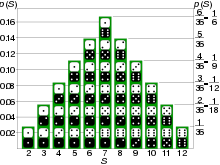7
7 (seven) is the natural number following 6 and preceding 8. It is the only prime number preceding a cube.
The seven Classical planets resulted in seven being the number of days in a week.[citation needed] It is often considered lucky in Western culture and is often seen as highly symbolic. Unlike Western culture, in Vietnamese culture, the number seven is sometimes considered unlucky.[citation needed]
In the beginning, Indians wrote 7 more or less in one stroke as a curve that looks like an uppercase ⟨J⟩ vertically inverted. The western Ghubar Arabs' main contribution was to make the longer line diagonal rather than straight, though they showed some tendencies to making the digit more rectilinear. The eastern Arabs developed the digit from a form that looked something like our 6 to one that looked like an uppercase V. Both modern Arab forms influenced the European form, a two-stroke form consisting of a horizontal upper stroke joined at its right to a stroke going down to the bottom left corner, a line that is slightly curved in some font variants. As is the case with the European digit, the Cham and Khmer digit for 7 also evolved to look like their digit 1, though in a different way, so they were also concerned with making their 7 more different. For the Khmer this often involved adding a horizontal line to the top of the digit.[1] This is analogous to the horizontal stroke through the middle that is sometimes used in handwriting in the Western world but which is almost never used in computer fonts. This horizontal stroke is, however, important to distinguish the glyph for seven from the glyph for one in writing that uses a long upstroke in the glyph for 1. In some Greek dialects of early 12th century the longer line diagonal was drawn in a rather semicircular transverse line.
On the seven-segment displays of pocket calculators and digital watches, 7 is the digit with the most common graphic variation (1, 6 and 9 also have variant glyphs). Most calculators use three line segments, but on Sharp, Casio, and a few other brands of calculators, 7 is written with four line segments because, in Japan, Korea and Taiwan 7 is written with a "hook" on the left, as ① in the following illustration.
While the shape of the character for the digit 7 has an ascender in most modern typefaces, in typefaces with text figures the character usually has a descender, as, for example, in ![]() .
.
Most people in Continental Europe,[2] and some in Britain and Ireland as well as Latin America, write 7 with a line in the middle ("7"), sometimes with the top line crooked. The line through the middle is useful to clearly differentiate the digit from the digit one, as the two can appear similar when written in certain styles of handwriting. This form is used in official handwriting rules for primary school in Russia, Ukraine, Bulgaria, Poland, other Slavic countries,[3] France,[4] Italy, Belgium, Finland,[5] Romania, Germany, Greece,[6] and Hungary.[citation needed]
